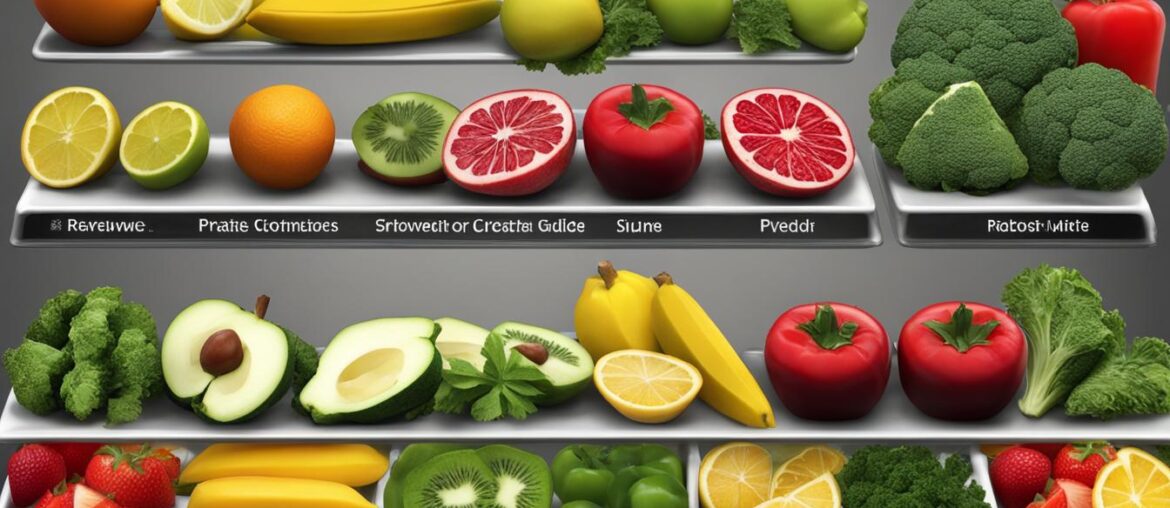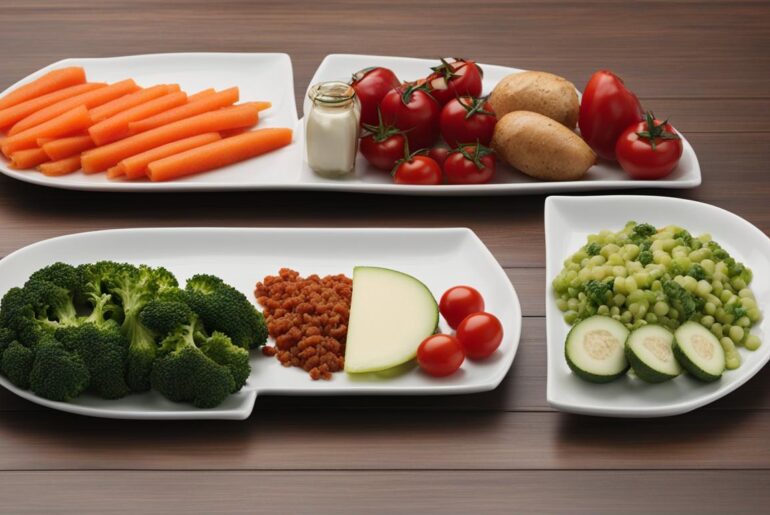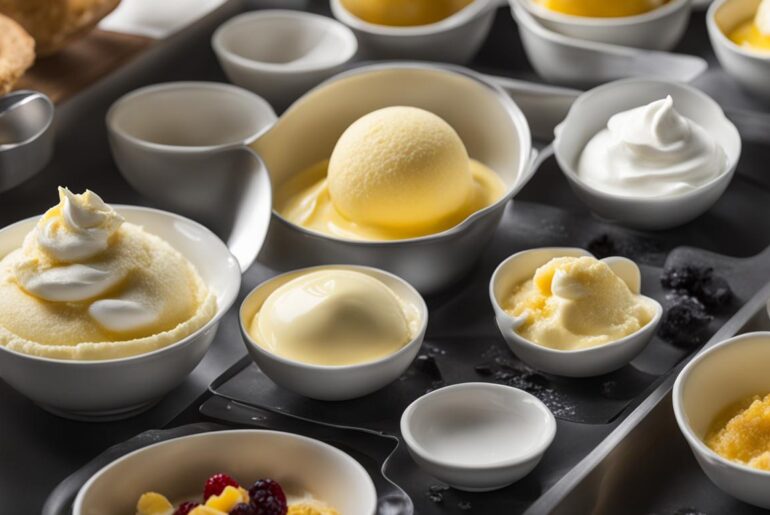Portion control plays a crucial role in maintaining a healthy diet and managing weight. With oversized portions becoming the norm these days, it’s important to find effective ways to control our portion sizes. In this section, I will explore some practical portion control hacks that can help you eat healthier and maintain a balanced diet.
When it comes to portion control, using a portion control plate can be a game-changer. These specially designed plates provide visual cues and portion sizes to help you manage your food intake and make healthier choices. By using a portion control plate guide, you can easily visualize the recommended proportions of different food groups, ensuring a well-balanced meal.
Key Takeaways:
- Portion control is essential for maintaining a healthy diet and managing weight.
- Using a portion control plate guide can help you visualize recommended food proportions.
- Portion control plates provide visual cues and portion sizes to help you make healthier choices.
- Mastering portion control plate usage can contribute to a balanced and nutritious diet.
- By controlling portion sizes, you can maintain a healthy weight and overall wellness.
Practical Portion Control Hacks
In this section, I will share some practical portion control hacks that can assist you in controlling your portion sizes and promoting a healthier eating habit. By incorporating these simple strategies into your daily routine, you can make significant progress towards achieving your health and wellness goals.
Use Smaller Plates and Bowls
Did you know that the size of your plate can influence how much you eat? Research has shown that using smaller plates and bowls can help create an illusion of a fuller plate, making you feel satisfied with smaller portions. Opt for plates and bowls that are no larger than 9-10 inches in diameter to promote portion control.
Fill Half Your Plate with Veggies
One effective way to control your portion sizes is to fill half of your plate with non-starchy vegetables like leafy greens, bell peppers, broccoli, and carrots. These veggies are low in calories and high in fiber, providing essential nutrients while helping you feel full. By prioritizing vegetables, you can naturally reduce the amount of higher-calorie foods on your plate.
Measure Serving Sizes
For accurate portion control, it’s important to measure your serving sizes using measuring cups or spoons (check out my post on using measuring cups here). This allows you to be mindful of the recommended portion sizes and prevent overeating (see my post here). By measuring ingredients and portions, you can better manage your calorie intake and maintain a healthy balance.
Pre-portion Snacks
Snacking can easily lead to mindless eating and consuming excessive calories. To avoid overeating, pre-portion your snacks into smaller containers or bags. This makes it easier to grab a controlled portion, preventing you from mindlessly eating from a large package or bag. Pre-portioned snacks also promote mindful eating and help you make healthier choices throughout the day.
Practice the “Plate Method”
The “Plate Method” is a simple yet effective technique for achieving balanced meals and controlling portion sizes. It involves dividing your plate into sections for each food group: one-half for non-starchy vegetables, one-fourth for lean proteins, and one-fourth for whole grains or starchy vegetables. This method ensures that your plate is balanced and provides you with the right proportions of nutrients.
By incorporating these practical portion control hacks into your daily routine, you can take control of your portion sizes and make healthier food choices. Remember to use smaller plates and bowls, fill half your plate with veggies, measure your serving sizes, pre-portion your snacks, and practice the “Plate Method” for balanced meals. These simple strategies can make a big difference in promoting a healthier lifestyle and maintaining a well-balanced diet.
Additional Tips for Portion Control
In this section, I will provide you with some additional tips to enhance your portion control efforts. By incorporating these strategies into your daily routine, you can achieve a balanced diet and maintain a healthy lifestyle.
1. Slow Down and Savor Each Bite
It’s easy to rush through meals, especially when we’re busy or distracted. However, eating too quickly can lead to overeating as our brain doesn’t have enough time to register fullness. Take the time to slow down and savor each bite. Enjoy the flavors, textures, and aromas of your food. Not only will this help you appreciate your meals more, but it will also give your body a chance to signal when you’ve had enough to eat.
2. Be Strategic with High-Calorie Foods
High-calorie foods can be delicious and satisfying, but they can also derail your portion control efforts if you’re not mindful. Instead of eliminating these foods completely, be strategic in how you enjoy them. Measure out reasonable portions or use smaller serving utensils to control the amount you consume. This way, you can still savor your favorite treats without going overboard.
3. Drink Water Before Meals
Drinking water before meals can help curb your appetite and prevent overeating. Water helps fill up your stomach, making you feel fuller and reducing the urge to eat larger portions. Before sitting down to a meal, try drinking a glass of water to quench your thirst and promote portion control.
4. Opt for Whole Foods
When it comes to portion control, opting for whole foods is a smart choice. Whole foods, such as fruits, vegetables, whole grains, lean proteins, and healthy fats, naturally provide appropriate portions and are packed with essential nutrients. By incorporating more whole foods into your diet, you’ll be able to maintain portion control without feeling deprived.
5. Practice Mindful Eating
Mindful eating is all about being present and fully engaged with your food. It involves paying attention to your body’s hunger and fullness cues, as well as the sensory experience of eating. Before you start eating, take a moment to assess your hunger level. During your meal, focus on each bite, savoring the flavors and textures. Pause occasionally to check in with your fullness level. By practicing mindful eating, you can better manage your portion sizes and develop a healthier relationship with food.
By incorporating these additional tips into your portion control journey, you’ll be well-equipped to maintain a balanced diet and achieve your health goals. Remember to slow down, be strategic with high-calorie foods, drink water before meals, opt for whole foods, and practice mindful eating. With consistency and mindful choices, you can take control of your portions and enjoy a healthier lifestyle.
Environmental Influences and Portion Distortion

When it comes to portion control, the environment we find ourselves in can have a significant impact on our eating habits. From the size of food packages to social norms, various factors can influence the amount of food we consume. Let’s explore how environmental influences and portion distortion affect our portion sizes and discover strategies to overcome these challenges.
One of the main environmental influences on portion control is the size of food packages. Research has shown that larger package sizes can lead to increased food consumption. When presented with larger packages, we tend to consume more without even realizing it. This phenomenon, known as the “portion distortion,” can result in consuming larger portions than what is considered appropriate.
In addition to package sizes, the amount of food we are served also plays a role in portion control. In social gatherings, we often find ourselves surrounded by abundance, where overeating is encouraged. It becomes challenging to resist the temptation of indulging in larger portions when everyone around us is doing the same. Over time, this can become the norm, leading to a distorted perception of appropriate portion sizes.
Portion size norms established by society and culture further contribute to our perception of appropriate portions. What we consider a “normal” serving size may not align with what is truly appropriate for our nutritional needs. By being aware of these societal norms and challenging them, we can overcome the influence they have on our portion sizes.
To combat these environmental influences on portion control, one strategy is to use smaller plates. Research has shown that using smaller plates can help reduce portion sizes and calorie intake. When a smaller plate is filled, it creates the illusion of a fuller plate, tricking our minds into feeling satisfied with smaller portions. This simple technique can be an effective tool in managing portion sizes (check out my post on managing portion sizes here).
By using smaller plates, we can create a visual cue that prompts us to consume appropriate portion sizes. When combined with mindful eating practices and awareness of environmental influences, using smaller plates becomes even more powerful in promoting portion control.
It’s important to remember that portion control is not about deprivation or strict rules. It’s about finding a balance that allows us to enjoy our favorite foods while nourishing our bodies appropriately. By understanding the environmental influences and portion distortion effects, and implementing strategies like using smaller plates, we can take control of our portion sizes and cultivate a healthier relationship with food.
Conclusion
In conclusion, mastering portion control plate usage is vital for achieving a balanced diet and long-term success in maintaining a healthy lifestyle (check this post out). By implementing practical portion control tips and techniques, as well as being mindful of environmental influences, you can effectively control your portion sizes and manage your weight (see my post here).
By using smaller plates and bowls, filling half your plate with nutritious vegetables, and measuring serving sizes, you can better manage your calorie intake and ensure a well-balanced meal. Pre-portioning snacks and practicing the “Plate Method” further contribute to portion control and healthier eating habits.
It is important to be strategic with high-calorie foods, drink water before meals to curb your appetite, and opt for whole, unprocessed foods. The practice of mindful eating, which involves paying attention to your body’s hunger and fullness cues, can also help you maintain portion control and avoid overeating.
Prioritizing portion control and embracing the benefits it brings to your overall health and wellness will pave the way for a balanced diet and long-term success in maintaining a healthy lifestyle. With portion control as a key component, you can enjoy your meals while achieving and sustaining your desired weight and health goals.




